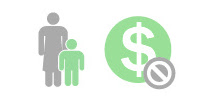
Intervention Overview
Self regulation includes setting, monitoring, and reflecting on goals. Research has shown that when “self-regulation instruction occurs within reading instruction[or other disciplines]. . .students can improve both academic and behavior outcomes” (Roberts et al., 2019, p. 79). Self-regulation helps individuals reach their goals and overcome setbacks. Ladd, Birch and Buhs (1999) found that kindergarteners who exhibited poor self-regulation and increased negative emotions early in the school year developed negative relationships with peers and teachers, had lower academic achievement, and lower peer acceptance by the middle of the school as compared to students with high levels of self-regulation. Teaching self-regulation strategies has been found to be particularly helpful at improving student motivation and achievement in mathematics (Perels et al., 2009; Wang et al., 2019). Surprisingly, one study found that educators spend less than 10 percent of instructional time on teaching self-regulation skills and strategies (Hamman et al., 2000).
Self-regulation strategies traditionally involve three parts: goal-setting and planning, goal monitoring, and self-reflection(Roberts et al., 2019). Educators can identify broad content and behavior goals for the class, and then encourage students to set individualized goals beneath the broader classroom goals. Before each lesson, consider teaching and modeling some of these goals using explicit instruction. Once students understand their goals, they monitor their behaviors through observation and notation. Strategies to help students monitor their goals is to do randomized goal checks, use a timer, or give them a self monitoring form. Self monitoring forms can help students see their progress and reflect on their next steps(Roberts et al., 2019). A self-monitoring form can be as simple as having students check a box each day if they completed or made progress towards their goal. If progress is not being made, have students consider what is and is not working, reteach the goal, or help them decide on a more appropriate goal. Additionally, teachers can teach students self-regulation strategies such as how to self-motivate, plan, concentrate, and how to handle distractions and mistakes (Perels et al., 2009, p. 23). Altogether, these strategies have been found to be effective when implemented with academic subjects (Roberts et al., 2019).
Intervention Guide
| Grade Level: |
Can be adapted to all grade levels. |
| Materials: |
Self-monitoring forms. Examples can be found in the references below (Roberts et al., 2019, p.82). Notebooks or journals can also be used for student self-monitoring and reflection. |
| Duration: |
A few minutes daily, integrated with classroom instruction. |
| Implementation: |
- Develop broad classroom goals, and assist students in developing individualized, explicit goals such as “I will. . .read all the directions before starting my work” (Roberts et al., 2019, p.80).
- You may wish to model some goal setting examples to help students with the previous step.
- Create self-monitoring forms for students to track their progress on achieving their goals.
- Check-in with each student on their self-monitoring reports or have them complete peer check-ins.
- After a period of time working on goals (such as a week, a month, a semester, etc.) have students reflect on their progress and make adjustments as needed.
|
Does it work?
Integrated self-regulation strategies were assessed within a mathematics class, with 53 sixth grade students participating in the study(Perels et al., 2009). One class, with half of the participating students, acted as a control group being taught a traditional math curriculum and the intervention group was taught mathematics with integrated self-regulation strategies for three weeks. The same teacher taught both classes. Self-regulation strategies taught over the course of the intervention included learner goal setting, self-motivation and monitoring using daily journals, problem-solving, coping with distractions, and handling mistakes effectively. Students in the intervention group were found to have more significant improvements in mathematic achievement by the end of the study as compared to their peers in the control classroom. They also showed greater understanding of self-regulation strategies and claimed to apply these strategies more frequently following the study (Perels et al., 2009).
A similar study was completed more recently to determine whether integrating self-regulation strategies into a lesson could help third grade students struggling with mathematics(Wang et al., 2019). The intervention was designed to help students develop a growth mindset and self-motivation through goal setting and self-monitoring while completing challenging tasks. Participants included students struggling with mathematics from 19 different third grade classrooms, who were taught self-regulation strategies in pairs with a tutor. 103 students participated in this intervention, with three weekly sessions for 13 weeks. The students who participated in the intervention outperformed the students who did not receive the intervention on their understanding of fractions, which was the mathematics content focus during the study. The results indicate that embedded self-regulation learning may improve student achievement, as well as their ability to persevere through learning challenges (Wang et al., 2019).
References:
Hamman, D., Berthelot, J., Saia, J., & Crowley, E. (2000). Teachers’ coaching of learning and its relation to students’ strategic learning. Journal of Educational Psychology, 92, 342-348.
Ladd, G.W., Birch, S.H. & Buhs, E.S. (1999). Children’s social and scholastic lives in kindergarten: related spheres of influence?. Child Development, 70(6), 1373-1400. https://doi.org/10.1111/1467-8624.00101
Perels, F., Dignath, C., & Schmitz, B. (2009). Is it possible to improve mathematical achievement by means of self-regulation strategies? Evaluation of an intervention in regular math classes. European Journal of Psychology of Education, 24(1), 17-31. https://doi.org/10.1007/BF03173472
Roberts, G. J., Solis, M. & Chance, B. (2019). Embedding self-regulation into reading interventions to support reading and behavior outcomes. TEACHING Exceptional Children, 52(2), 78-86. https://doi.org/10.1177/0040059919874306
Wang, A. Y., Fuchs, L. S., Fuchs, D., Gilbert, J. K., Krowka, S., & Abramson, R. (2019). Embedding self-regulation instruction within fractions intervention for third graders with mathematics difficulties. Journal of Learning Disabilities, 52(4), 337–348. https://doi.org/10.1177/0022219419851750